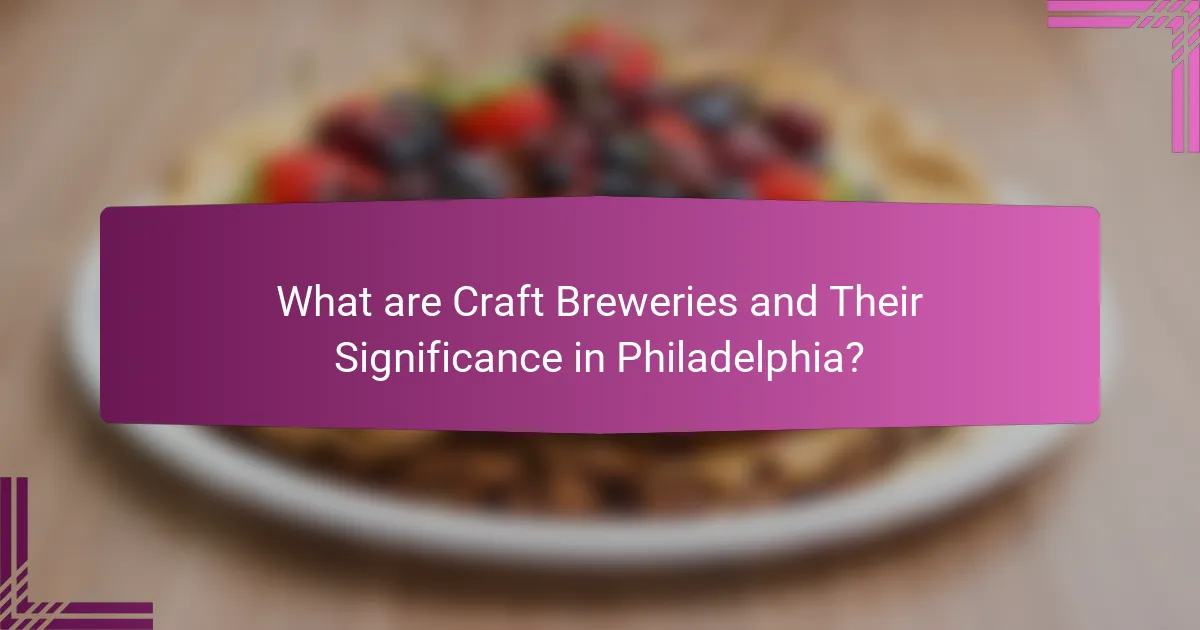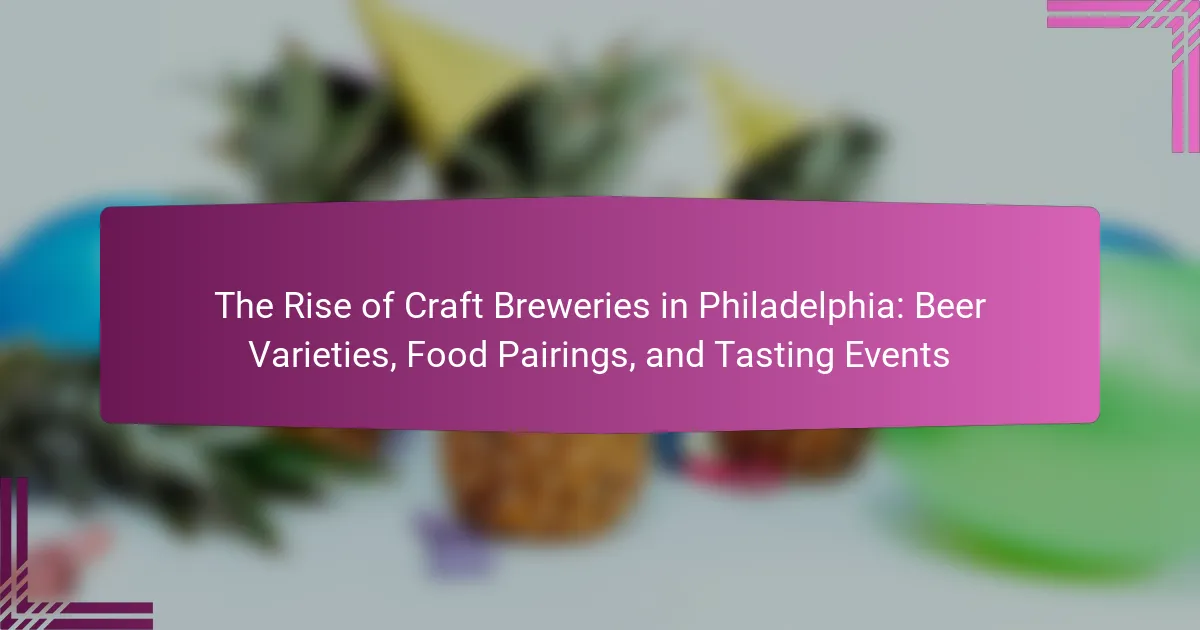
What are Craft Breweries and Their Significance in Philadelphia?
Craft breweries are small, independent breweries that produce limited quantities of beer. They emphasize quality, flavor, and traditional brewing methods. In Philadelphia, craft breweries have become significant for several reasons. They contribute to the local economy by creating jobs and attracting tourism. Philadelphia has over 100 craft breweries, making it a vibrant hub for beer enthusiasts. These breweries often focus on unique beer styles, fostering innovation in the craft beer scene. They also serve as community gathering spots, hosting events and food pairings. The rise of craft breweries has revitalized neighborhoods and promoted local culture.
How have craft breweries evolved in Philadelphia?
Craft breweries in Philadelphia have evolved significantly over the past two decades. The number of breweries increased from only a few in the early 2000s to over 80 by 2023. This growth reflects a rising interest in local and artisanal beer. The craft beer scene has diversified, offering a wide range of styles, including IPAs, stouts, and sour ales. Many breweries emphasize local ingredients and unique brewing techniques. Events like beer festivals and tasting sessions have become popular, fostering community engagement. The city’s craft breweries now contribute substantially to the local economy, generating millions in revenue each year. This transformation has positioned Philadelphia as a notable hub in the craft beer movement.
What historical factors contributed to the rise of craft breweries in Philadelphia?
The rise of craft breweries in Philadelphia was influenced by several historical factors. The city has a rich brewing tradition dating back to the colonial era. This history laid the foundation for local interest in beer production. In the late 20th century, a shift in consumer preferences occurred. People began seeking unique and locally produced beer options. This demand encouraged the establishment of small, independent breweries. Additionally, the deregulation of brewing laws in the 1980s facilitated new business opportunities. The growth of the local food movement also played a role. It connected craft breweries with local restaurants and farmers. This synergy further fueled the craft beer scene in Philadelphia.
How do local regulations impact the growth of craft breweries?
Local regulations significantly impact the growth of craft breweries. These regulations dictate licensing, zoning, and operational hours. Stringent licensing requirements can delay brewery openings. Zoning laws may restrict where breweries can operate. Additionally, regulations on alcohol sales can limit hours and distribution methods. Craft breweries must navigate these complexities to thrive. For instance, in Pennsylvania, the Liquor Control Board regulates brewery licenses, influencing market entry. Compliance with health and safety regulations also affects operational costs. Overall, local regulations shape the competitive landscape for craft breweries.
What types of beer are produced by Philadelphia’s craft breweries?
Philadelphia’s craft breweries produce a diverse range of beer types. Common varieties include IPAs, stouts, porters, and lagers. Many breweries also create sour ales and wheat beers. Seasonal and specialty brews are often featured as well. The city is known for its innovative approaches to brewing. Local ingredients are frequently used to enhance flavor profiles. Collaborations among breweries create unique offerings. The craft beer scene in Philadelphia is vibrant and continually evolving.
What are the most popular beer styles among local craft breweries?
The most popular beer styles among local craft breweries include IPAs, stouts, and pale ales. IPAs, or India Pale Ales, are known for their hoppy flavor and aroma. They often feature a strong bitterness balanced by fruity notes. Stouts are characterized by their dark color and rich, roasted flavors. They can range from dry to sweet, offering a variety of taste experiences. Pale ales are lighter in color and have a moderate hop presence. These styles are commonly brewed by craft breweries due to their popularity and consumer demand. According to the Brewers Association, IPAs consistently rank as the top-selling craft beer style in the United States.
How do seasonal variations influence beer production in Philadelphia?
Seasonal variations significantly influence beer production in Philadelphia. Breweries adapt their recipes to align with seasonal ingredients. For example, summer often sees lighter beers like wheat ales. Winter typically features darker, richer styles such as stouts and porters. Temperature changes also affect fermentation processes. Warmer months may accelerate yeast activity, while cooler temperatures can slow it down. Seasonal festivals further drive demand for specific beer types. Breweries often release limited-edition seasonal brews to attract customers. This strategy helps them stand out in a competitive market. Overall, seasonal variations shape both production and consumer preferences in Philadelphia’s craft beer scene.
What role do food pairings play in the craft beer experience?
Food pairings enhance the craft beer experience by complementing flavors and aromas. They create a balanced tasting profile that elevates both the food and the beer. For instance, hoppy IPAs can be paired with spicy dishes to offset heat. Conversely, malty stouts often match well with chocolate desserts, intensifying sweetness. Studies show that pairing food with specific beer styles can improve overall satisfaction. The Brewers Association highlights that thoughtful pairings can lead to a more enjoyable dining experience. This approach encourages exploration of different beer varieties. Ultimately, food pairings play a crucial role in maximizing the sensory experience of craft beers.
How can different beer styles complement various cuisines?
Different beer styles can enhance various cuisines through complementary flavors and textures. For instance, a hoppy IPA can balance spicy dishes, enhancing the overall taste experience. Lagers, with their crispness, pair well with lighter foods like salads and seafood. Stouts, rich and creamy, complement desserts such as chocolate cake, adding depth to the flavors. Wheat beers, often fruity, can enhance the freshness of dishes like ceviche or fruit salads. Each beer style brings unique attributes that can either contrast or complement the flavors of the food. This pairing principle is widely recognized in culinary practices, with many chefs recommending specific beers to enhance their dishes. Studies in food and beverage pairing have shown that the right beer can elevate the dining experience significantly.
What are some recommended food pairings for popular local beers?
Popular local beers pair well with specific foods to enhance flavors. For example, a hoppy IPA complements spicy dishes like buffalo wings. A rich stout pairs excellently with chocolate desserts or grilled meats. A crisp lager matches well with light salads or seafood. Wheat beers are ideal with citrusy dishes or fresh fruit. Amber ales go well with roasted vegetables or burgers. These pairings are based on flavor profiles that balance or complement each other.
What tasting events are available for craft beer enthusiasts in Philadelphia?
Craft beer enthusiasts in Philadelphia can attend various tasting events throughout the year. Notable events include the Philadelphia Craft Beer Festival, which features over 75 breweries. This festival typically occurs in the spring and showcases a wide range of local and national craft beers. Another popular event is the Philly Beer Week, an annual celebration with numerous tastings and events at local breweries and bars. Additionally, many breweries host their own tasting events, such as beer releases and seasonal festivals. These events provide opportunities to sample unique brews and meet the brewers.
How do craft beer festivals enhance the local brewing culture?
Craft beer festivals enhance the local brewing culture by providing a platform for breweries to showcase their products. These events foster community engagement and promote local artisans. Attendees gain exposure to diverse beer varieties, which encourages exploration and appreciation. Festivals often feature educational seminars about brewing techniques and beer styles. This knowledge-sharing strengthens the connection between brewers and consumers. Additionally, craft beer festivals stimulate local economies by attracting visitors. According to the Brewers Association, craft breweries contributed over $82 billion to the U.S. economy in 2019. Overall, these festivals play a vital role in cultivating a vibrant craft beer scene.
What are the key features of a successful tasting event?
A successful tasting event features well-curated selections, engaging atmosphere, and knowledgeable hosts. Curated selections ensure a diverse range of flavors and styles. An engaging atmosphere encourages social interaction and enjoyment. Knowledgeable hosts provide insights and answer questions, enhancing the experience. Properly paired food amplifies the tasting experience by complementing the beverages. Clear organization aids in smooth operation, allowing guests to focus on tasting. Feedback collection post-event helps improve future tastings. These elements contribute to a memorable and enjoyable tasting event.
How can newcomers best navigate the craft beer scene in Philadelphia?
Newcomers can best navigate the craft beer scene in Philadelphia by exploring local breweries and taprooms. Visiting breweries like Yards, Victory, and Tired Hands offers firsthand experience with diverse beer styles. Participating in brewery tours provides insights into the brewing process and unique flavors. Utilizing apps like Untappd helps track tastings and discover new beers. Attending local beer festivals showcases a variety of options and fosters community connections. Engaging with knowledgeable staff enhances understanding of beer pairings and recommendations. Philadelphia’s craft beer scene features over 100 breweries, ensuring ample choices for newcomers.
What tips can help first-time visitors enjoy craft beer tastings?
First-time visitors can enjoy craft beer tastings by following a few key tips. Start by asking the staff for recommendations based on your taste preferences. Many breweries offer flights, which allow you to sample several beers at once. Take notes on each beer to remember what you liked. Pay attention to the appearance, aroma, and flavor of each beer. Pair your tastings with complementary food options available at the brewery. Stay hydrated by drinking water between tastings. Finally, embrace the experience by engaging with the staff and other visitors to learn more about the craft beer culture. These practices enhance enjoyment and understanding of craft beer.
How can one discover hidden gem breweries in the city?
To discover hidden gem breweries in the city, explore local craft beer guides and apps. These resources often highlight lesser-known breweries. Check social media platforms for recommendations and reviews from beer enthusiasts. Attend local beer festivals to sample various offerings and meet brewery owners. Join local beer clubs or online forums to connect with like-minded individuals. Utilize Google Maps to search for breweries with high ratings but fewer reviews. Look for breweries that focus on unique styles or local ingredients, as they often provide distinctive experiences. Engaging with the local community can lead to discovering these hidden gems.
The main entity of this article is craft breweries in Philadelphia, which are small, independent breweries known for producing limited quantities of high-quality beer. The article covers the significance of these breweries in the local economy, their evolution over the years, and the historical factors that contributed to their rise. It discusses the diverse beer varieties produced, popular styles among local breweries, and the impact of seasonal variations on production. Additionally, the article highlights the importance of food pairings in enhancing the craft beer experience and outlines various tasting events available for enthusiasts, emphasizing how these festivals contribute to the local brewing culture.


